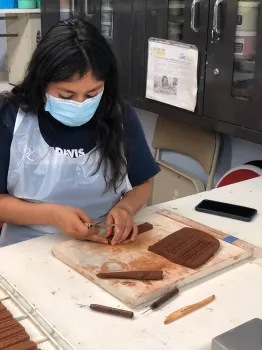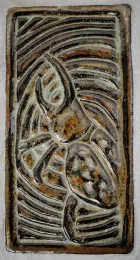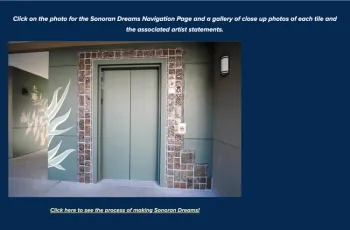
The tiles, the work of UC Davis students taught by UC Davis faculty members Diane Ullman and Gale Okumura, include everything from beetles to birds, from corn to cacti, and from “The Dream Catcher of Love” to “The Hope of the Horned Toad.”
Encompassing 78 tiles and more than 110 handmade trim pieces, the project “enriches the lives of our 300-plus residents,” said URC residents and artists Maxine Solomon and Vicki Panagotacos, co-chairs of URC art procurement.
The students learned to fuse science with art in two classes, “Entomology 001: Art, Science and the World of Insects Honors Section,” and “Freshman Seminar 002: Exploring Visual Language and Symbolism with Ceramics and a Community-Engaged Learning Project,” taught by UC Davis distinguished professor Diane Ullman, professor of entomology and co-founder of the UC Davis Art/Science Fusion Program, and professional graphic designer Gale Okumura of Okumura Design, a retired continuing lecturer in the UC Davis Department of Design. Artist Amanda Larson of Half Moon Bay, formerly of Davis, led the installation.
In ENT 001, the students learned about the natural history of insects and how insects are woven into human culture through art, religion, literature, and film. In the freshman seminar class, the students explored how people use symbolic representation in design and visual narrative to enhance expression and understanding of ideas and concepts.
On the Web. Both classes focused on life in the Sonoran Desert and the symbols of the indigenous communities. A newly created Sonora Dreams site on the UC Davis Department of Entomology and Nematology website leads visitors through the art-creating experiences.

Love for Family. “I would do anything to protect my family, and I love them very much,” Yee wrote. “Spiders also represent creative powers, and I feel like that is a good representation of me. The spiral in the big circle represents continuation. No matter what happens, I will always be with my family and my love will be for eternity. Each bear claw is also connected to a feather which are marks of honor. My whole family honors each other and respects one another. In the end, we're all connected and will love each other until the end.”
“I've never considered myself an artist nor have I ever thought that a day would come where a piece of art I've made would be on display,” wrote Alondra Bravo-Garcia, then a first-year student in aerospace engineering who titled her work, “Revolutionizing Insects.”
“As an engineering student at Davis, I've always focused on math and science,” she related. “However, I had the opportunity to study a marvelous scarab beetle named Dynastes grantii.” Commonly known as the Western Hercules beetle or Grant's rhinoceros beetle, it is a scarab beetle that “improves nutrient recycling and soil conditions.”
Unique Beauty. Bravo-Garcia wrote that “to give these underappreciated insects some recognition for their hard work, I decided that I wanted to reflect their unique beauty and give an idea of their environment within my tile. I had never worked with clay before, but I was fortunate enough to receive assistance from peers and Professor Ullman. With their help, I was able to make my vision come to life and create a tile that I'm proud to exhibit. Within this tile, you'll be able to see a Grant's rhinoceros beetle with its unique elytra that contains irregular spots on an ash tree stump even if you're currently in California and not Arizona. This was an unforgettable experience and I've become extremely grateful for being given the privilege to learn the many benefits insects have and how insects can help us develop sustainable designs. As an engineering student at Davis, I look forward to designing solutions based on nature.”

Sun Ray on Cornerstones. A sun ray brightens each cornerstone on the top row of the Sonoran Dreams project. They are the work of Professor Ullman. “I don't always get to do my own artwork as I lead large scale projects like Sonoran Dreams,” she wrote. “I am delighted to present a sun symbol as the cornerstones of the elevator surround, one at each side of the top row. The sun symbolizes life-giving abundance with its warmth, giving light and life to planet, thus a fitting symbol overseeing this portal.”
Noted Solomon: “We are very thankful to Diane and Gale and to UC Davis for their interest in doing projects that connect the university, the students and the community. Vicki and I really enjoyed working with the students, attending a few classes that Diane and Gale taught and heard the students' presentations as they developed them. It was wonderful to see their original concepts develop into a completed tile that incorporated what they learned about their chosen insect, its habitat and a complete visual project that now enhances a building in the Davis area.”
“Another thing that was gratifying to me as an artist,” said Solomon, “was to see many of the students who had no prior art involvement, find excitement in completing a visual art project that incorporated all they were learning in their entomology lab with Diane, and design principles with Gale.”
Stimulating Visual. Panagotacos said that the tiles “bring life to an area of the building that was mundane, at best. We are grateful for Diane, Gale and the students as they provided a stimulating visual for the residents to ponder, while waiting for the elevator to arrive!”
“It was a privilege to be included in the classroom--to listen to the students present their design rationale and show their sincere interest in creating the final tiles,” Panagotacos said. “While Maxine and I weren't there for Diane and Gale's initial tutoring, they clearly were the main drivers in presenting the project as a cross-discipline--both an intellectual and a creative experience. Having taught public school art myself, this experience caused me to reflect on why the arts aren't coupled with ‘core' curriculum more often. Possibly Diane and Gale's years of success in combining the two, can influence other UC Davis instruction.
Professor Ullman, a celebrated teacher and artist, received the Entomological Society of America (ESA) National Excellence in Teaching Award in 2014 and the UC Davis Academic Senate's 2022 Distinguished Teaching Award for undergraduate teaching. Known for her superb teaching, her students praise her for bringing art-science fusion alive in innovative ways. During the COVID-19 pandemic, one student commented: "My experience in her course last spring was one that lifted my spirits, enriched my education, and strengthened my love for art and science during a time when it was difficult to feel positive about anything.”
Art/Science Fusion Program Director. Ullman, who holds a doctorate in entomology from UC Davis, joined the UC Davis entomology faculty in 1994. A former department chair who served as associate dean in the College of Agricultural and Environmental Sciences, she continues to direct the UC Davis Art/Science Fusion Program that she co-founded in September 2006.
Okumara, who taught visual communication in the UC Davis Department of Design, provides creative design solutions. Her designs include agricultural products and graphics for non-profit organizations, including California Cancer Research Program, Napa Valley Symphony and Friends for Kids.
Larson, who directed the installation, says her art practice “resides within two spheres; one being community built public art and the other a studio-based practice.” She is passionate about “facilitating projects that have the potential to foster human connection, activate and engage the public and space, and build a sense of ownership and place.”
The University Retirement Community is one of those places.
(Editor's Note: The photos are courtesy of Diane Ullman and Gale Okumura)

